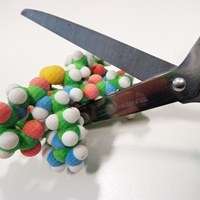Scientists have discovered an extraordinary protein-cutting enzyme that has also evolved to glue proteins together, a finding that may be valuable in the production of therapeutic drugs.
They found the unusual enzyme in an ordinary plant, the sunflower.
The researchers, from The Universities of Western Australia and Queensland, have unravelled the manufacturing route sunflowers use to make a super-stable protein ring.
The enzyme at the heart of the synthesis, AEP, has been shown to have evolved a second ability – not only can AEP cut proteins, but some also have an unusual ability to join them together.
By using artificial proteins that mimic the parent molecule of a drug-like protein from sunflower seeds the team, led by UWA, have discovered some AEP enzymes can convert parent molecular 'string' into a small, stable 'bracelet-like' protein ring. They also discovered a degrading pathway that cleans up any misprocessing and makes the process 100 per cent efficient in sunflower seeds.
Although this work is of interest to researchers by providing an understanding of how protein machinery can stabilise proteins, it also provides a starting point for making custom enzymes that can join proteins together.
The study was published overnight and features on the cover of the May issue of the international journal Chemistry & Biology. The article shows how the enzyme AEP (ASPARAGINYL ENDO-PEPTIDASE) is needed to create a small circular protein in sunflower seeds.
"You can find AEP enzymes in all plants where they defend plants from pathogens and mature seed store proteins, but in sunflower AEP appears to have specialised to produce a small cyclic peptide that we think protects the seeds from insects," said lead author, UWA's Dr Kalia Bernath-Levin.
"The way AEP does this is really interesting. Enzymes can accelerate reactions in both directions, but many reactions go just one way. For example, making a protein bond needs energy and for the two pieces to be held close together. So it's much easier for an enzyme to cut proteins than join them."
"The reaction isn't really ligation as the energy for that comes from cutting at the same time. It's a mouthful, but we're calling it a cleavage-dependent intramolecular transpeptidation reaction, which basically means a cutting and a ligation reaction happening at the same time makes the critical bond," Professor Joshua Mylne said.
"Now we're desperate to know exactly what changes in AEP allowed it to do this reaction because looking at its sequence, you'd just expect this ligating AEP to be like any other protein-cutter."
The study "Peptide macrocyclisation by a bifunctional endoprotease" was supported by the Australian Research Council.
More information: "Peptide Macrocyclization by a Bifunctional Endoprotease," Chemistry & Biology, Available online 7 May 2015, ISSN 1074-5521, dx.doi.org/10.1016/j.chembiol.2015.04.010
Journal information: Cell Chemical Biology
Provided by University of Western Australia





















